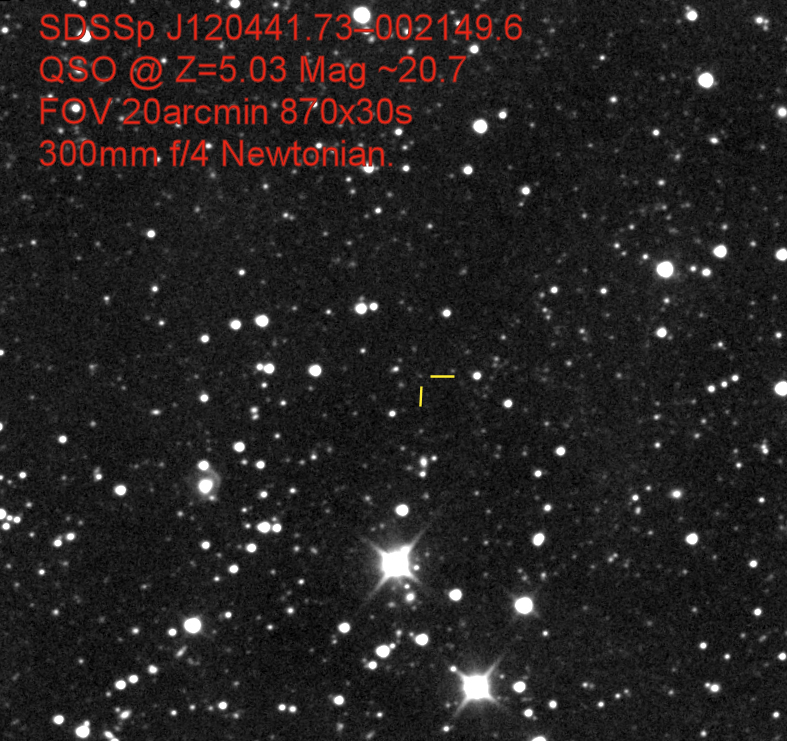Observation by Grant Privett: QSO Z=5.03
Uploaded by
Observer
Grant Privett
Observed
2022 Apr 10 - 00:00
Uploaded
2022 Apr 29 - 19:35
Equipment
- 300mm f/4 Newtonian
- NQ6+Rowan belt upgrade
- Starlight Xpress Trius 694 mono
Exposure
870x 30s
Location
Near Salisbury
Target name
SDSSp J120441.73–002149.6
Title
QSO Z=5.03

About this image
SDSSp J120441.73–002149.6 is a Z=5.03 (or 5.08 depending on who you ask) Quasar in Virgo. Beyond about Z=5 the Hydrogen lines are redshifted out of the visible and distant QSos are rather easier to see in the very near IR (which is difficult with bog standard Silicon based CCDs) and are often discovered using multicolour surveys. The magnitude depends strongly on the waveband you specify, but in the U band you are looking at mag 24.4 and in the I band mag 19.7. However, I generated a Zp using Gaia stars and got a mag of about 20.7 or so. The detection is at an SNR of 34.
The image was created with 870x 30second frames on Moonless nights in April when the object was more than 30 degs elevation. I found out the hard way that its near the satellite GEO belt and also the ecliptic as there were lots of movers. I think this means mag 21 is just out of range for my system as it stands with 30s exposures.
The object appears slightly elongated - which I had not expected - but, as I made AstroArt throw away images where stars were elongated, I think its real.
I will ty this again next year with 900s exposures when my OAG is working.
Edited: to emphasise very near infra-red
Files associated with this observation
Like this image
Comments
Interesting. Spectroscopically I've been to z=4.5 and 20.2g 18.4r where Lyman alpha emission is obvious, well above the noise at ~6700A.
https://britastro.org/observations/observation.php?id=20210411_134753_85f4b3ebf4faaefe
Here it would shift it to 7350A so still within range. An SNR of 5 say would be more than sufficient to still detect it but it would be among the Telluric absorption bands.
Its well placed. I look forward to seeing that!
I think at 735nm the sensitivity of the chip has dropped off by about a third from its peak. Still usable but back illuminated would be nice.
https://www.researchgate.net/publication/257764605_High-Redshift_Quasars_Found_in_Sloan_Digital_Sky_Survey_Commissioning_Data_II_The_Spring_Equatorial_Stripe
The link above is a paper on it with spectra. Impressed to see that I saw as much as the 2.3m in the survey, but they were using a filter and a 54sec exposure whereas my image was 24,000 sec and unfiltered....
Actually, if anyone fancies doing spectra. The nebulous object on the lower left side of the frame is noted as a galaxy by Simbad. I can't say it looks like one to me.
I've just had a look in SDSS at the flux calibrated spectrum for this QSO compared with the one I measured at z=4.56. Apart from the higher redshift, the spectrum is very similar and the flux is ~1/3 so a spectrum might be possible. The air mass will be higher though from here and it does not get fully dark after 5th May so it will have to wait for next season now
"Actually, if anyone fancies doing spectra. The nebulous object on the lower left side of the frame is noted as a galaxy by Simbad. I can't say it looks like one to me."
It does look rather odd. It is identified as LEDA 1146381 in SIMBAD and there is a spectrum in SDSS with a suggested z=0.2 which is given in SIMBAD. Looking at the spectrum though the z is obviously wrong (The Balmer lines are clearly at Z~0.1)
It is a E+A galaxy apparently. No. 11 in table 1 of this paper with Z=0.094
https://academic.oup.com/mnras/article/409/2/567/1036758
I had never heard of these before. That's my something new learnt today !
Looking at the SDSS image there appear to be two star like concentrations within it, one of which is identified as the source of the spectrum so perhaps the nebulosity is in the foreground. The nebulosity is too faint for a spectrum from me I fear though.
© British Astronomical Association 2025
Registered charity no. 210769
Registered company no. 117572
For more information including contact details,
click here.
Our Terms of Use are here.
Our Privacy Policy is here.

The BAA image gallery was designed and
built by Dominic Ford.
Image gallery software
©
Dominic Ford
2020–2024
